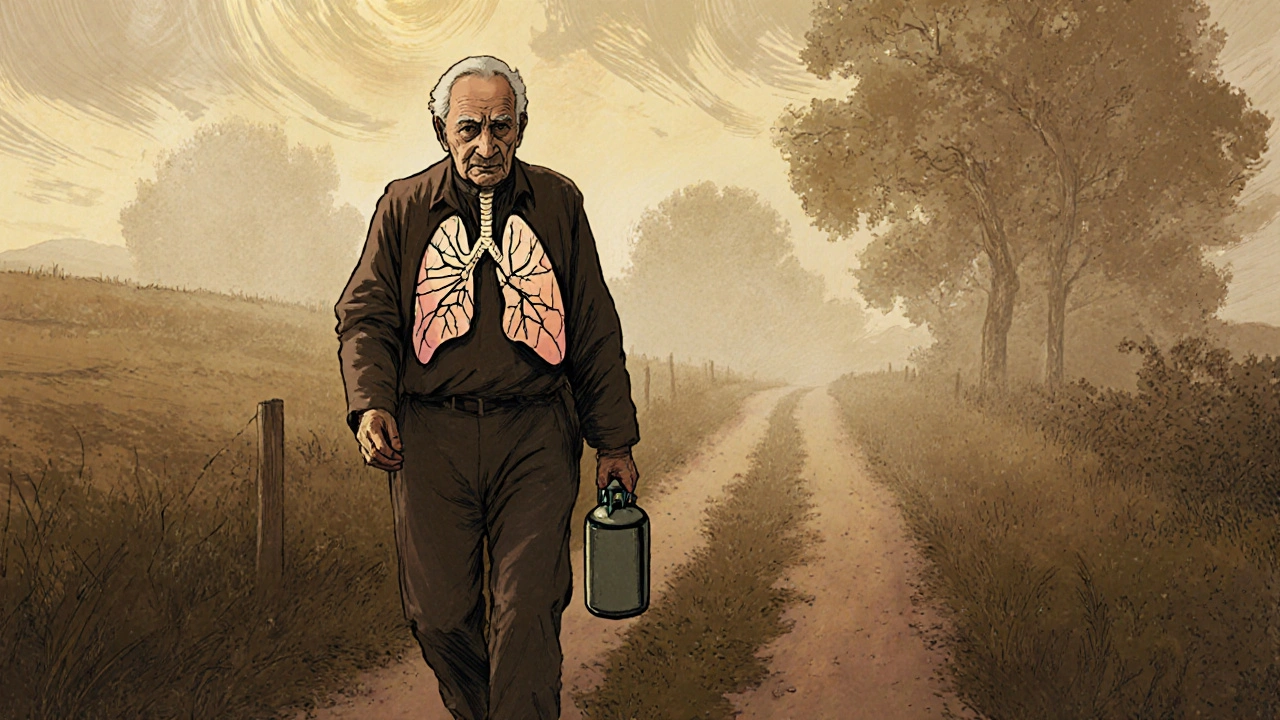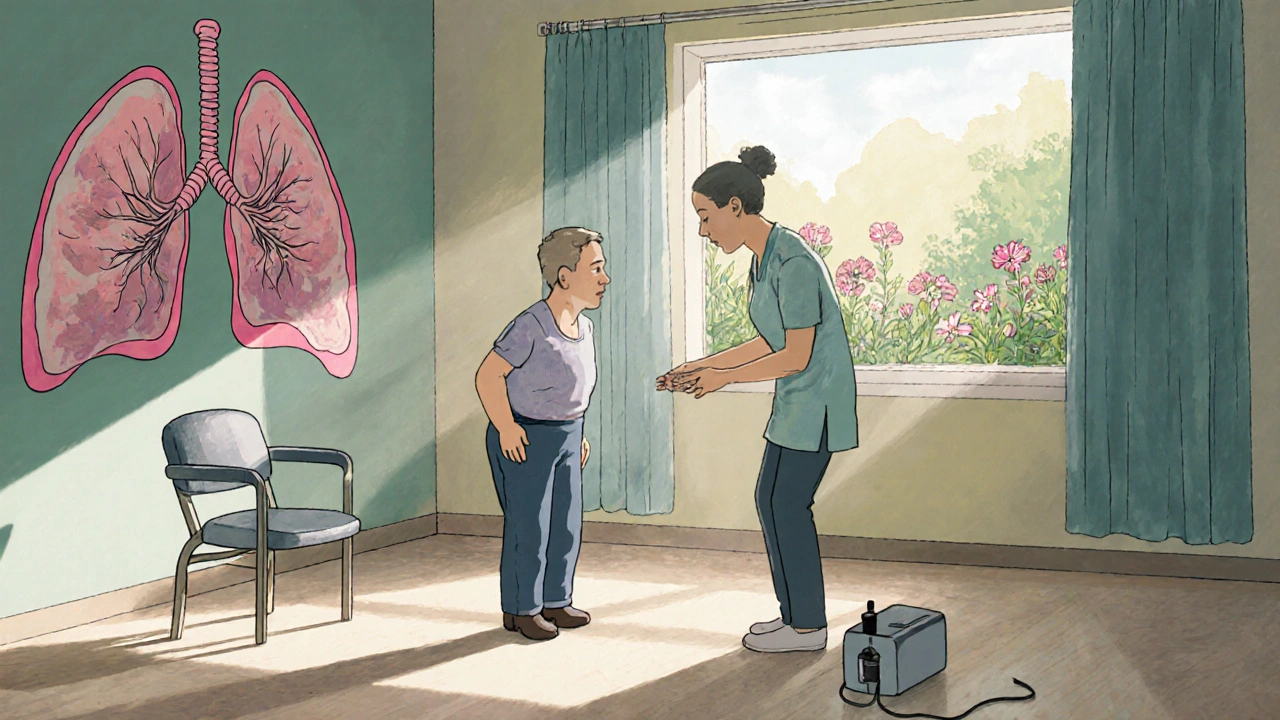Interstitial Lung Disease: Understanding Progressive Scarring and Modern Treatment Options
 Nov, 18 2025
Nov, 18 2025
What Is Interstitial Lung Disease?
Interstitial lung disease (ILD) isn’t one single illness-it’s a group of more than 200 conditions that cause inflammation and scarring in the lungs. This scarring, called fibrosis, happens in the interstitium, the thin tissue between the air sacs (alveoli) where oxygen passes into your blood. When this tissue thickens and stiffens, your lungs can’t expand properly. You start to feel short of breath, even during simple tasks like walking to the mailbox or getting dressed.
Unlike asthma or COPD, where airways narrow, ILD affects the lung’s structure itself. Once scarred, lung tissue doesn’t heal. That’s why early diagnosis matters so much. The most common form is idiopathic pulmonary fibrosis (IPF), which makes up 20-30% of all ILD cases. It’s called "idiopathic" because doctors don’t know exactly what triggers it. But other types are linked to autoimmune diseases like rheumatoid arthritis, long-term exposure to dust or asbestos, certain medications, or radiation therapy.
How Do You Know If You Have ILD?
The symptoms don’t come on suddenly. They creep in over months or even years. Most people first notice they’re out of breath during activities they used to handle easily-climbing stairs, carrying groceries, or walking the dog. A dry, hacking cough that won’t go away is another big red flag. About 92% of ILD patients report this symptom.
As the disease progresses, other signs show up: fatigue that doesn’t improve with rest, unexplained weight loss, and sometimes, clubbing of the fingers-where the tips widen and round out. If your oxygen levels drop below 88% at rest, you’ll likely need supplemental oxygen. Many people don’t realize these aren’t normal signs of aging. In fact, a 2023 survey found that nearly half of ILD patients were first told they just had asthma or were "getting old." It takes an average of 11 months to get the right diagnosis.
How Is ILD Diagnosed?
Diagnosing ILD isn’t just about listening to your lungs. It takes a team. High-resolution CT scans (HRCT) are the gold standard. These scans show the fine details of lung tissue, revealing patterns of scarring that help doctors tell one type of ILD from another. But even the best scans can miss early changes. New AI tools are now helping radiologists spot subtle fibrosis with 92% accuracy-better than human eyes alone.
Doctors also use pulmonary function tests. These measure how much air you can breathe in and out (FVC) and how well your lungs transfer oxygen into your blood (DLCO). In ILD, both numbers drop. A 6-minute walk test is simple but powerful: if you can’t walk more than 50 meters without needing to stop, your risk of complications goes up sharply.
For unclear cases, a lung biopsy might be needed. But now, many centers use a multidisciplinary approach-pulmonologists, radiologists, and pathologists review all the data together. This cuts down on misdiagnosis, which still happens in 25-30% of cases.

What Are the Treatment Options?
There’s no cure for ILD, but treatments can slow the scarring and help you feel better. The biggest breakthrough came with two antifibrotic drugs: nintedanib (Ofev®) and pirfenidone (Esbriet®). Both are approved for IPF and have been shown to cut the rate of lung function decline by about half over a year. They don’t reverse scarring, but they keep it from getting worse faster.
These drugs aren’t easy to tolerate. About 65% of people on pirfenidone get sun-sensitive rashes. Nearly 60% have nausea or stomach pain. Many need to start at low doses and slowly increase. Nintedanib can cause diarrhea. But for many, the trade-off is worth it-slowing progression means more time with good quality of life.
In 2023, the FDA approved a new drug called zampilodib, the first new antifibrotic in nearly a decade. Early trials show it reduces lung function decline by 48% compared to placebo. It’s already being used for progressive pulmonary fibrosis, even in cases that aren’t classic IPF.
Non-Drug Treatments That Make a Difference
Medications aren’t the whole story. Pulmonary rehabilitation is one of the most effective tools-and it’s underused. These programs last 8 to 12 weeks and include supervised exercise, breathing techniques, and education. People who complete them walk 45-60 meters farther in the 6-minute test and report less anxiety. They learn how to conserve energy, use oxygen properly, and recognize when they’re having a flare-up.
Oxygen therapy becomes necessary when blood oxygen drops below 88%. About 55% of IPF patients need it within two years. Modern portable oxygen systems let people stay active. But learning to use them correctly takes training-most patients need 3 to 4 sessions to feel confident.
Lifestyle changes matter too. Quitting smoking is non-negotiable. Avoiding dust, chemicals, and mold helps. Getting vaccinated against flu and pneumonia reduces the risk of infections that can trigger dangerous flare-ups.

What’s on the Horizon?
The future of ILD treatment is getting personal. Doctors now test for the MUC5B gene variant, which increases IPF risk by 6-fold. People with this marker are monitored more closely. Blood tests for other biomarkers are being tested to catch ILD before symptoms start.
More than 25 clinical trials are active right now. Some are testing new antifibrotic combinations. Others explore stem cell therapy and drugs that target inflammation at the cellular level. Researchers are also developing better ways to measure how patients feel-not just lung function, but energy levels, sleep quality, and ability to do daily tasks.
AI is playing a growing role. Machine learning models can now predict which patients will decline fastest based on CT scans, lung function trends, and even voice patterns. This helps doctors decide who needs aggressive treatment early.
Living With ILD: What Patients Say
Real-life experiences show how complex ILD is. On patient forums, 78% say they were misdiagnosed at least once. Many describe the loneliness of needing oxygen in public or canceling plans because they’re too tired. Caregivers often spend 20+ hours a week helping with oxygen tanks, mobility, and appointments.
But there’s hope. People who join support groups and stick with rehab report better moods and more independence. Those who learn to manage their symptoms early stay out of the hospital longer. One patient in Perth, diagnosed with IPF in 2022, now walks 30 minutes daily with her portable oxygen and volunteers at a local lung health group. "I don’t live like I used to," she says. "But I still live."
When to See a Specialist
If you’ve had a persistent dry cough or shortness of breath for more than 6 weeks-and your doctor hasn’t found a clear cause-ask for a referral to a pulmonologist. Don’t wait for symptoms to get worse. Early action can change the course of the disease.
Specialized ILD clinics, now common in major hospitals, offer the best chance for accurate diagnosis and timely treatment. Community doctors often miss early signs. If you’re in a rural area, telehealth consultations with ILD centers are becoming more available.

Dana Dolan
November 19, 2025 AT 09:39Also, the part about AI spotting fibrosis better than humans? Mind blown. We’re living in the future.
Nick Lesieur
November 20, 2025 AT 06:19Angela Gutschwager
November 22, 2025 AT 02:16Dion Hetemi
November 23, 2025 AT 01:25Kara Binning
November 23, 2025 AT 16:46river weiss
November 25, 2025 AT 05:28Also, the MUC5B gene testing? That’s the future. Early detection before symptoms = game changer.
Brian Rono
November 26, 2025 AT 07:33Zac Gray
November 27, 2025 AT 19:36Also, pulmonary rehab? Do it. I thought I was too tired. Turns out, being tired was the reason I needed it. It’s not magic. It’s just science you have to show up for.
Steve and Charlie Maidment
November 27, 2025 AT 19:41Michael Petesch
November 29, 2025 AT 00:29Chuck Coffer
November 30, 2025 AT 09:43Marjorie Antoniou
November 30, 2025 AT 15:42Andrew Baggley
December 1, 2025 AT 10:27Frank Dahlmeyer
December 3, 2025 AT 10:16